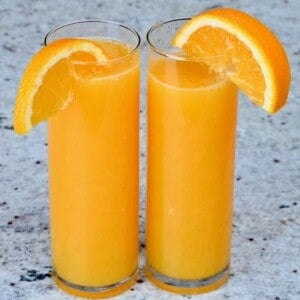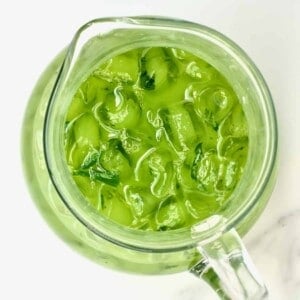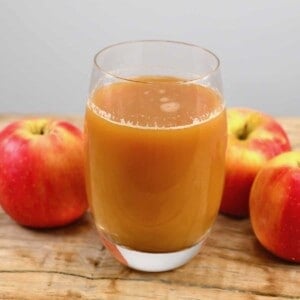This post may contain affiliate links. Please read our disclosure policy.
How to make beet juice with or without a juicer. This sweet and earthy beetroot juice recipe is loaded with vitamins, minerals, and antioxidants. Optional add-ins included.

Raw beet juice, a vegetable juice made from fresh beets (beetroot), boasts an early and mildly sweet taste, great on its own or in juice blends. Learning how to make beetroot juice at home is cheaper than purchasing the juice.
It’s also fresher and contains more nutrients, and you can make it using a juicer or blender! You can also flavor the juice in different ways. The end result is a delicious and detoxifying drink.
Plus, you can easily mix it with other favorites like homemade carrot juice, homemade apple juice, homemade orange juice, homemade cranberry juice, or homemade ginger juice.
Want to save this recipe?
Watch the video
Ingredients

- Raw beets: You can use red, golden, or candy beets, though red beets have higher water content.
How to make beet juice
Prepare the beets: Beets are root vegetables, so they’re likely to have dirt on them, so washing them well is necessary. Fill a bowl with water and brush away any dirt with a vegetable brush. Then rinse them well. Next, roughly chop the washed beets into pieces.

Blender Method: For this method, you will need to add some water, so keep in mind that the juice will be slightly diluted. Transfer the beet pieces into a blender and pour 1/4-1/3 cup of water. Blend the beets and water until smooth and juicy. Then, transfer the mixture to a nut milk bag or fine mesh strainer layered with cheesecloth to strain the juice from the pulp. Note that the juice STAINS, so use materials you don’t mind staining permanently.
Juicer method: Feed the beet pieces through the juicer chute and let the machine do all the work.

The juice is now ready to be enjoyed straight away. You can also enjoy it as part of other fruit and veggie juice blends. Furthermore, beetroot juice also works as a natural colorant for drinks (cocktails, mocktails, soda), jelly, popsicles, baked goods (like muffins and quick breads), and more!

What to add to beet juice
Alone, this juice can taste overwhelmingly earthy, which is why I love to add ginger and lemon:
- Beet ginger juice with lemon: For every five beets, use around 50g (~1.8 oz) ginger root (or 1 Tbsp ginger powder) and the juice from one lemon or lime.
Other options include apple juice, orange juice, carrots, cucumbers, celery, strawberries, leafy greens (e.g., flat-leaf parsley), and fresh mint leaves.
FAQs
Store any leftovers in an airtight bottle/jar in the fridge for 1-2 days. You can also freeze the juice for 3 months in Ziplock bags, freezer-safe jars, or large ice cube trays (depending on the material, expect to stain). Allow it to thaw in the fridge overnight before enjoying it.
Add the raw pulp to your smoothies for extra fiber, or mix it into vegan burger patties. You can also dehydrate and turn it into powder. Dry at room temperature (if you live in a warm, dry climate) or in an oven/dehydrator. Once dried, grind it into a powder using a blender or coffee/spice grinder. You can then use the beetroot powder in smoothies and baked goods (like cookies, quick bread, pizza) or to color food. Alternatively, you can compost the pulp.
Just like radish greens, beet greens are edible. You can toss them raw into salads (try them in roasted beet salad), add them to smoothies, sauté them (just like arugula or spinach), or even make chips using the method for kale chips.
I recommend drinking it on an empty stomach 30 minutes before breakfast. This will help it absorb quickly into your system.
More juice recipes you might like
If you try this beet juice recipe, let me know how it goes in the comments below. I’d appreciate a recipe card rating and would love to see your recipe recreations – tag me on Instagram @Alphafoodie!

Beet Juice Recipe (2 Methods)
Equipment
- Blender/Food processor -AND-
Ingredients
- 2.5 lb beet
With a juicer, this yields about 1 pint/600 ml of juice
Instructions
- Wash the beets well. Fill a bowl with water and brush away any dirt with a vegetable brush. Rinse them well.
- Roughly chop the washed beets into 4-8 pieces. Then juice them following your preferred method.
Juicer method
- Feed the beet pieces through the juicer chute. The machine will do all the work. Enjoy!
Blender method
- Place the beet pieces into a blender and pour 1/4-1/3 cup of water. Blend until smooth and juicy.
- Transfer the mixture to a nut milk bag or fine mesh strainer layered with cheesecloth and strain the juice from the pulp. Enjoy!
Video
Notes
Nutrition
Nutrition information is automatically calculated, so should only be used as an approximation.














Do I peel the beets first befour juicing them
Hi Richard,
You don’t have to peel them as long as you wash and scrub them well to remove any dirt. I hope this helps.
What a great idea! I made beetroot juice in my vitamix along with 1/2 cup or so apple juice and a chunk of fresh ginger. So delicious!! And after scraping down the sides then blending on high speed, I decided not to strain it since I’m using it in a smoothie and not drinking straight. Beetroot juice is $9 a bottle where live and this is a great recipe and idea to just make your own!
Hi Lisa! Thanks for sharing. That sounds amazing!
So easy in the blender- I used 3 beetroots and 1/2 a cup of water. Needed to stop and mix it around about 5 times to puree it properly. I used Chux cloth to strain it. I put on gloves, put the Chux over a glass jug, poured over the beetroot puree, then gathered the top of the Chux, twisted it closed and then squeezed the juice through. I did it twice to make sure no pulp was left in the juice.
Hey Lisa!
Thanks for sharing your method. Sounds like you nailed it with the straining! Glad to hear it was easy in the blender.
Happy juicing! Samira
So easy in the blender!
Hey Lisa! I’m so glad to hear you found it easy! Blending makes everything quick and fun.